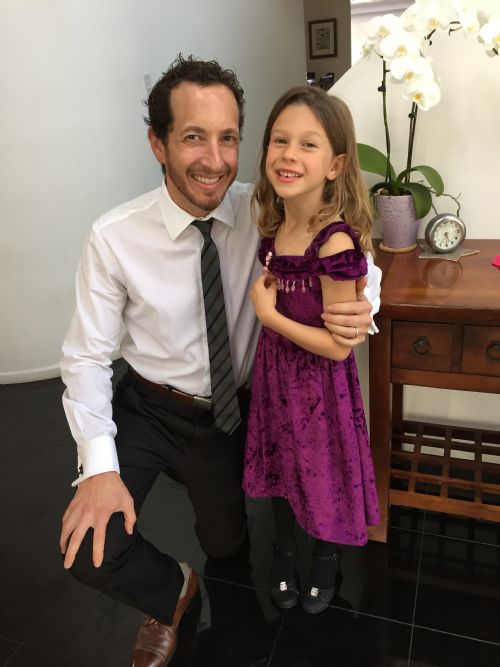
Erika Weiss, team captain of Team Rainbows & Unicorns, recently shared an update on her husband Ara with us. And we want to share this inspiring story with you:
“Ara had his 6-month post-treatment scan last week, and there are no signs of cancer! The plan going forward is that he will get a scan every 4-months until he reaches the 2-year post-treatment mark. After that, the scan interval will lengthen to every 6-months until he reaches the 5-year post-treatment mark, and then once a year thereafter. Ara has recovered well, and is looking and feeling great.
Also, as you may recall, last year I participated in the Tour de Pier to raise funds for three important cancer charities in our area, one of which in particular, the Cancer Support Community of Redondo Beach, has been a tremendous resource for us. Last year, I raised over $5,000 riding as Team Ara’s Angels. This year, I am hoping to match that amount, riding as Team Rainbows & Unicorns!”
Below is Erika’s full story from her 2015 Tour de Pier fundraising page. We can’t wait to join the Weiss family and others as we ride in place, move charity forward and celebrate these stories of survival & recovery.
“Cancer-Free are two of the best words in the English language! The journey to get to the point where we heard those words from the doctors was fraught with tremendous highs and lows, times of hopelessness and times of hopefulness.
In November of 2013, when I was eight months pregnant with our second daughter, my healthy, fit, 40-year old husband Ara was diagnosed with Thymic Carcinoma, a rare cancer that manifested itself as a very large tumor in the center of his chest, and which was pressing up against vital life organs. To say the diagnosis was a shock is an understatement, especially at this point in our lives. But from the instant of the diagnosis, we were determined to do “whatever it takes” to beat this. Aside from seeking out the best doctors, researching medical treatments, getting second, third, and even fourth opinions, and becoming laymen experts in all things cancer, one of the most important things we did was to seek out a Cancer Support Group. Fortunately for us, the Cancer Support Community of Redondo Beach was close by, and they immediately welcomed us in to their community. Ultimately the support we’ve received, the knowledge we’ve gained and the relationships we’ve formed have proven to be invaluable tools throughout the journey. We want to ensure that those who come after us will benefit from the same support, so raising funds through the Tour de Pier to support the Cancer Support Community, as well as the other important cancer support organizations is something very important, and near and dear to our hearts.
Once Ara was diagnosed, he started a rigorous chemotherapy treatment at USC. After four rounds, the scans showed that the tumor was shrinking, but not enough to make surgery an option, at least not at USC. Through our research, we found that surgery would give Ara the best chance for long-term survival, so before we ruled it out entirely, we sought out the opinions of additional surgical oncologists, which included visits to Stanford and City of Hope. Initially, surgeons at both hospitals felt that they could perform the surgery, but then both came back with the news that they had reconsidered, and would not be willing to move forward with surgery. Disappointed, but determined to beat this, we moved on to radiation therapy – this treatment too proved to be quite challenging as we learned that the initial radiation plan would deliver a lethal dose of radiation to Ara’s lungs. Fortunately, our radiation oncologist at USC was able to devise a better radiation plan that would kill the cancer, while sparing as many healthy lung cells as possible. After 30 daily radiation treatments, Ara rang a bell signifying the end of treatment – and then we waited…
Once Ara had his first set of post-radiation scans, which showed that the tumor was dying, we visited a radiation oncologist at UCLA whom we had met with prior to the start of radiation, for a second opinion. The doctor at UCLA looked at Ara’s scans and said there was really nothing more that could be done – but Ara insisted that he present his scans at the next tumor board meeting, which he reluctantly agreed to. A few days later, we received a call back from UCLA that the tumor board met, and there were no additional treatment options they could offer. Needless to say, we were pretty down. But lo and behold, a few days later we received another call from UCLA that one of their surgeons, who had not been at the tumor board meeting the previous week had reviewed Ara’s scans, and wanted to see us immediately – we were shocked, and didn’t really know what to expect. Dr. Jay Lee, Chief of Thoracic Surgery at UCLA squeezed us in for a visit, where we were shocked to hear him say that he “didn’t see any reason why surgery couldn’t be done.” He wanted Ara to come back for a battery of tests and scans to ensure that he was fit for surgery. Based on our prior experience, we were preparing ourselves to hear Dr. Lee tell us that he had changed his mind – but he didn’t – instead he talked us through exactly what the surgery would entail. By the end of a long meeting, including a battery of tough questions, and some tears (mine), Ara had signed some papers and started the ball rolling for surgery.
On September 2, 2014, almost exactly a year to the day when he first started feeling the symptoms that would lead to the cancer diagnosis, Ara endured a grueling 8-hour surgery at UCLA, where the amazing team of surgeons were able to do what none of the other surgical oncologists thought was possible – they removed the entire tumor from Ara’s chest, with negative margins! Since that surgery in September, he has been focusing on healing and getting his strength back, as well as living life to the fullest! The plan going forward is that he will get scans every 4-months for the first two years, as the recurrence rate is highest in the first two years post-treatment, and then the scan interval will be increased to every 6-months until he has reached the five year post-treatment mark, and then to once a year after that.
Cancer definitely threw our family for a loop, and has been quite a roller coaster, but ultimately, what we’ve learned, and what we hope others will take from this, is that there is always hope.”
